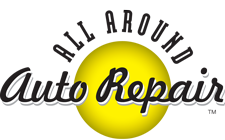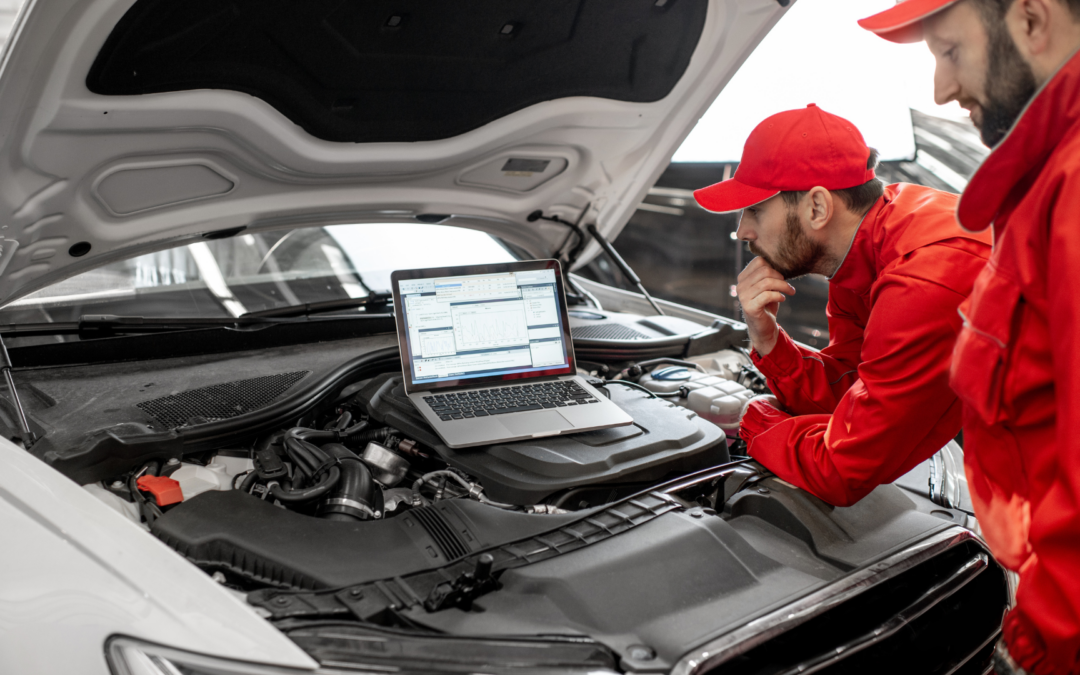In this blog, we’ll delve into how vehicle diagnostics work, explain common error codes, and discuss why professional diagnostics are crucial for your car’s health.
Understanding Vehicle Diagnostics
Every vehicle manufactured in the last few decades comes equipped with an onboard diagnostics system, commonly referred to as OBD (On-Board Diagnostics). This system continuously monitors the car’s performance and various components, from the engine and transmission to the exhaust and fuel systems.
If any part of the vehicle isn’t working as it should, the OBD system detects this anomaly and triggers a warning light—typically the “check engine” light on your dashboard. This light is often a source of anxiety for drivers, as it’s not immediately clear what the problem might be. That’s where diagnostic tools and error codes come in.
How Vehicle Diagnostics Work
1. The OBD System
The OBD system is like your car’s internal doctor. It monitors various aspects of vehicle health and performance by using sensors located in critical areas. These sensors constantly collect data and feed it into the car’s computer. When the system detects something unusual—be it an emissions issue, engine misfire, or transmission problem—it stores this information in the form of an error code.
The OBD system is accessible via an OBD-II port, a universal interface that mechanics use to connect a diagnostic scanner or code reader to retrieve information. This port is usually located beneath the dashboard, close to the driver’s seat.
2. Error Codes and Their Meanings
Error codes are standardized, meaning they follow a specific format to help mechanics and drivers identify issues. A typical error code consists of five characters, such as P0300 or B1234. Here’s a quick breakdown of what these characters represent:
- The First Character: Identifies the system where the problem is located.
- P: Powertrain (engine and transmission)
- B: Body (airbags, lighting, seatbelts)
- C: Chassis (brakes, suspension)
- U: Network communication
- The Second Character: Indicates whether the code is generic (0) or specific to the manufacturer (1).
- The Third Character: Specifies the subsystem, such as fuel or ignition.
- The Last Two Characters: Identify the exact problem within the subsystem.
For example, the code P0300 indicates a random engine misfire, while a code like B1234 could point to a specific issue within the body system. Each code helps narrow down the cause of the problem and can guide mechanics to the appropriate fix.
Common Diagnostic Error Codes
Let’s look at some common error codes that vehicle owners often encounter, along with a brief explanation of what each means.
1. P0300: Random/Multiple Cylinder Misfire Detected
This error code signifies that the engine is experiencing misfires in one or more cylinders. Misfires can be caused by various issues, such as faulty spark plugs, a bad ignition coil, or problems with the fuel injectors. If left unaddressed, misfires can lead to decreased engine performance and potentially severe engine damage.
2. P0171/P0174: System Too Lean (Bank 1/Bank 2)
Codes P0171 and P0174 indicate that the engine is running “lean,” meaning there’s too much air and not enough fuel in the mixture. This can happen due to a vacuum leak, a faulty mass airflow sensor, or clogged fuel injectors. Running lean can lead to poor fuel efficiency and increased emissions.
3. P0420: Catalyst System Efficiency Below Threshold
This code suggests a problem with the catalytic converter, which is responsible for reducing harmful emissions. A faulty catalytic converter can lead to increased emissions, poor fuel economy, and eventually, engine damage.
4. P0455: Evaporative Emission System Leak (Large Leak)
This code means that there is a significant leak in the vehicle’s evaporative emission control system, which controls the release of fuel vapors. This code is often triggered by a loose or faulty gas cap but could also indicate more severe issues, such as a damaged fuel line.
5. C0035: Left Front Wheel Speed Sensor
This is an example of a chassis-related error code. It indicates an issue with the left front wheel speed sensor, which is a component of the anti-lock braking system (ABS). A faulty speed sensor can affect braking performance and the stability of your vehicle.

Why Professional Diagnostics Matter
While it’s possible to purchase an OBD-II scanner and attempt to diagnose issues yourself, it’s often best to leave this to the professionals. Here are a few reasons why professional diagnostics are essential.
1. Accurate Problem Identification
A single error code doesn’t always tell the whole story. For example, an error code indicating a misfire could have multiple underlying causes, such as a failing ignition coil, spark plugs, or fuel injectors. Professional mechanics have access to advanced diagnostic tools and the experience necessary to accurately diagnose the root cause of an issue.
2. Preventative Maintenance
During a professional diagnostic check, mechanics don’t just focus on fixing the immediate problem; they also assess the overall health of your vehicle. This proactive approach allows them to identify potential issues before they escalate, saving you time and money on future repairs.
3. Cost-Effectiveness
While a DIY diagnosis might seem cheaper at first, misdiagnosing a problem can lead to expensive repairs. For example, replacing the wrong part or ignoring a deeper issue can lead to further damage down the line. Professional diagnostics help ensure that repairs are done right the first time, which can be more cost-effective in the long run.
4. Manufacturer Knowledge
Professional mechanics stay up-to-date on the latest developments in automotive technology and have access to specialized equipment and knowledge specific to various car manufacturers. This expertise allows them to perform diagnostics that are more accurate than what a simple OBD-II reader can provide, especially for more advanced or unique problems.
5. Warranty and Peace of Mind
Many auto repair shops, including All Around Auto Repair, offer warranties on parts and labor. By choosing professional diagnostics and repairs, you gain peace of mind knowing that your vehicle has been serviced by qualified professionals, backed by a guarantee.
When to Get a Diagnostic Test
While some drivers only seek diagnostics when the check engine light comes on, it’s a good idea to get a diagnostic test during these situations:

- Annually or During Routine Maintenance: An annual diagnostic test helps catch any issues before they become major problems. It’s a proactive approach to keeping your vehicle in good health.
- Before a Long Trip: If you’re planning a long road trip, a diagnostic test can help ensure that your vehicle is road-ready and unlikely to break down.
- After Buying a Used Car: A comprehensive diagnostic test can reveal any hidden issues in a used vehicle, helping you avoid potential headaches.
- When You Notice Strange Symptoms: If you notice unusual sounds, smells, or changes in vehicle performance, it’s wise to schedule a diagnostic test. Even if the check engine light isn’t on, there could be a hidden issue.
How to Decode Your Car’s Signals
Understanding the warning signs your vehicle gives you is essential to keeping it running smoothly. Here are some tips to help you decode your car’s signals:
- Don’t Ignore the Check Engine Light: While it’s tempting to ignore this light if your vehicle seems to be running fine, it’s often the first indication of an underlying problem. Getting a diagnostic test as soon as possible can prevent more severe issues.
- Pay Attention to Changes in Performance: Reduced fuel efficiency, sluggish acceleration, or unusual noises can indicate that something is wrong. These changes may be subtle but can point to issues within your vehicle’s systems.
- Use Diagnostic Codes as a Guide, Not a Solution: An error code gives you a starting point but doesn’t necessarily indicate the exact problem. Professional mechanics will interpret the code and investigate further to find the root cause.
Conclusion: Professional Diagnostics for a Healthier Vehicle
Vehicle diagnostics are a powerful tool for identifying and addressing issues before they turn into costly repairs. While basic OBD-II scanners can help you gain some insight into what might be wrong, they’re no substitute for professional diagnostics. Expert mechanics, like those at All Around Auto Repair, have the knowledge, experience, and equipment needed to accurately interpret error codes, diagnose underlying issues, and perform the necessary repairs.
When it comes to your vehicle, don’t rely on guesswork. If you see the check engine light or notice unusual symptoms, schedule a diagnostic test with All Around Auto Repair. Our skilled technicians are here to help you decode what your car is trying to tell you and keep it running at its best.
Contact Us Today:
- Location: 1244 Central Ave, Santa Rosa, CA 95401
- Phone: (707) 837-0646
- Website: All Around Auto Repair
Stay informed, stay proactive, and keep your vehicle in top condition with regular diagnostics from All Around Auto Repair.
FAQ: Vehicle Diagnostics Explained
1. What are vehicle diagnostics, and why are they important?
Vehicle diagnostics involve using advanced tools to interpret error codes and identify issues within a car’s internal systems. These diagnostics ensure timely detection of problems, preventing costly repairs. Did you know that ignoring a “check engine” light can lead to a repair cost increase of up to 50%?
2. How does an OBD-II scanner work in vehicle diagnostics?
An OBD-II scanner connects to your car’s onboard diagnostics port to retrieve error codes. Think of it as your car’s translator, helping you understand problems like engine misfires or emissions issues. OBD-II systems became standard in vehicles post-1996, making diagnostics universal.
3. Can you diagnose a car problem without professional tools?
While basic issues like a loose gas cap can be identified visually, most problems require tools like an OBD-II scanner for accuracy. Professional mechanics can pinpoint hidden causes, saving you from misdiagnosing complex problems. DIY attempts may miss up to 40% of underlying issues.
4. What do common error codes like P0300 mean?
Error codes, like P0300, indicate issues such as random engine misfires. This problem might stem from faulty spark plugs, ignition coils, or fuel injectors. Ignoring these codes could lead to a 25% drop in fuel efficiency and long-term engine damage.
5. How often should you run a vehicle diagnostic test?
Experts recommend a diagnostic test annually or before long trips. Regular checks catch small issues before they turn into costly repairs. Over 80% of drivers who schedule diagnostics annually report fewer breakdowns.
6. Can diagnostics improve fuel efficiency?
Absolutely! Diagnostics can identify problems like a clogged air filter or faulty oxygen sensor. Fixing these can boost fuel efficiency by up to 15%, saving you hundreds annually.
7. Are professional diagnostics worth the cost?
Yes, professional diagnostics provide a comprehensive vehicle health check. They often uncover issues overlooked by basic scanners, saving you from expensive repairs. On average, professional diagnostics can reduce repair costs by 30%.
8. What’s the difference between OBD-I and OBD-II systems?
OBD-I systems were vehicle-specific, while OBD-II is standardized across all cars since 1996. OBD-II not only retrieves error codes but also monitors real-time data like speed and fuel efficiency.
9. Can error codes resolve themselves without repair?
Some minor issues, like temporary sensor glitches, may clear after driving. However, persistent codes signal deeper problems requiring attention. Ignoring them can escalate repair costs by 50%.
10. What should you do if your check engine light flashes?
A flashing check engine light signals a serious problem, like a catalytic converter failure or engine misfire. Pull over immediately and get your car inspected to avoid permanent damage. This could save repair bills exceeding $2,000.





